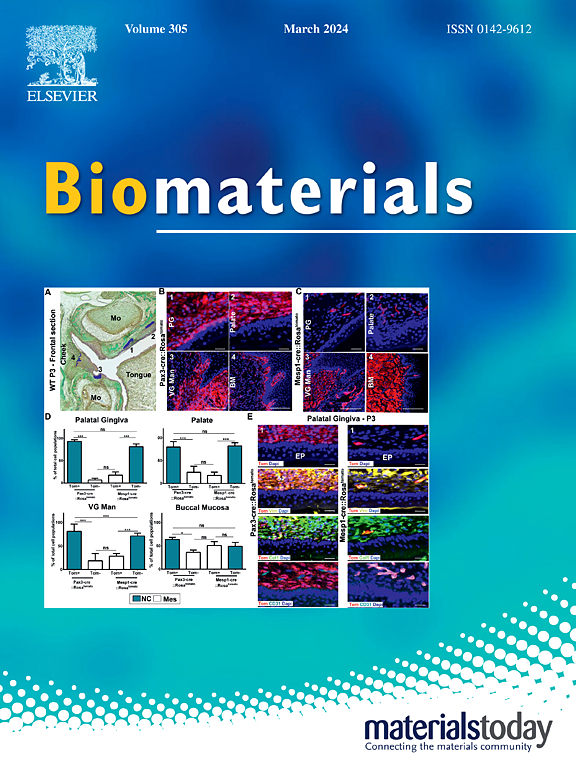Nasal-to-brain delivery of CCR5 antagonist for reshaping the dysregulated microglia-neuron axis and enhancing post-traumatic cognitive function
IF 12.9
1区 医学
Q1 ENGINEERING, BIOMEDICAL
引用次数: 0
Abstract
The dysregulation of the microglia-neuron axis plays a pivotal role in the pathogenesis of cognitive dysfunction following traumatic brain injury (TBI). The C–C chemokine receptor 5 (CCR5), markedly upregulated on both microglia and neurons post-injury, serves as a crucial mediator in the neuroinflammatory response and consequent neurological deficits. However, the therapeutic application of CCR5 antagonists in TBI is impeded by the delivery barriers presented by the blood-brain barrier (BBB) and their limited neuron-targeting efficacy. In this study, we introduce a novel nasal-to-brain delivery nanoplatform designed to facilitate the efficient brain delivery of DAPTA, a peptide antagonist of CCR5, aiming to inhibit CCR5 signaling and improving cognitive function following TBI. Biocompatible chitosan nanocarriers grafted with cell-penetrating peptide (TAT) and neuron-binding lactoferrin (Lf) were initially fabricated, demonstrating substantial DAPTA loading capacity, active mucosal and neural transportation, and enhanced neuron-targeting capabilities. The dual-engineered nanodrugs (DA@LT NPs) effectively penetrated the trigeminal and olfactory nerves, significantly enhancing the transport of DAPTA into the brain following intranasal delivery. In a TBI-induced mouse model, DA@LT NPs markedly alleviated the neuroinflammatory response, promoted M2 microglia polarization, protected neurons from pyroptosis, and improved both motor and cognitive functions of animals. The non-invasive intranasal delivery of the therapeutic CCR5 peptide antagonist using these mucus-penetrating and neuron-targeting nanoformulations presents a promising intervention for ameliorating neurological inflammation and cognitive impairments associated with TBI.

CCR5拮抗剂经鼻至脑可重塑失调的小胶质神经元轴并增强创伤后认知功能
小胶质细胞-神经元轴的失调在创伤性脑损伤(TBI)后认知功能障碍的发病机制中起关键作用。C-C趋化因子受体5 (CCR5)在小胶质细胞和神经元损伤后均显著上调,在神经炎症反应和随之而来的神经功能障碍中起着重要的调节作用。然而,CCR5拮抗剂在TBI中的治疗应用受到血脑屏障(BBB)的递送障碍及其有限的神经元靶向作用的阻碍。在这项研究中,我们介绍了一种新的鼻腔至脑递送纳米平台,旨在促进CCR5肽拮抗剂DAPTA的有效脑递送,旨在抑制CCR5信号传导并改善TBI后的认知功能。初步制备了细胞穿透肽(TAT)和神经元结合乳铁蛋白(Lf)的生物相容性壳聚糖纳米载体,显示出大量的DAPTA负载能力、活跃的粘膜和神经运输能力以及增强的神经元靶向能力。双工程纳米药物(DA@LT NPs)有效渗透三叉神经和嗅觉神经,显著增强经鼻给药后DAPTA进入大脑的运输。在tbi诱导的小鼠模型中,DA@LT NPs显著减轻神经炎症反应,促进M2小胶质细胞极化,保护神经元免于焦凋亡,改善动物的运动和认知功能。使用这些穿透黏液和靶向神经元的纳米制剂,无创鼻内递送治疗性CCR5肽拮抗剂,为改善与TBI相关的神经炎症和认知障碍提供了一种有希望的干预措施。
本文章由计算机程序翻译,如有差异,请以英文原文为准。
求助全文
约1分钟内获得全文
求助全文
来源期刊

Biomaterials
工程技术-材料科学:生物材料
CiteScore
26.00
自引率
2.90%
发文量
565
审稿时长
46 days
期刊介绍:
Biomaterials is an international journal covering the science and clinical application of biomaterials. A biomaterial is now defined as a substance that has been engineered to take a form which, alone or as part of a complex system, is used to direct, by control of interactions with components of living systems, the course of any therapeutic or diagnostic procedure. It is the aim of the journal to provide a peer-reviewed forum for the publication of original papers and authoritative review and opinion papers dealing with the most important issues facing the use of biomaterials in clinical practice. The scope of the journal covers the wide range of physical, biological and chemical sciences that underpin the design of biomaterials and the clinical disciplines in which they are used. These sciences include polymer synthesis and characterization, drug and gene vector design, the biology of the host response, immunology and toxicology and self assembly at the nanoscale. Clinical applications include the therapies of medical technology and regenerative medicine in all clinical disciplines, and diagnostic systems that reply on innovative contrast and sensing agents. The journal is relevant to areas such as cancer diagnosis and therapy, implantable devices, drug delivery systems, gene vectors, bionanotechnology and tissue engineering.
 求助内容:
求助内容: 应助结果提醒方式:
应助结果提醒方式:


